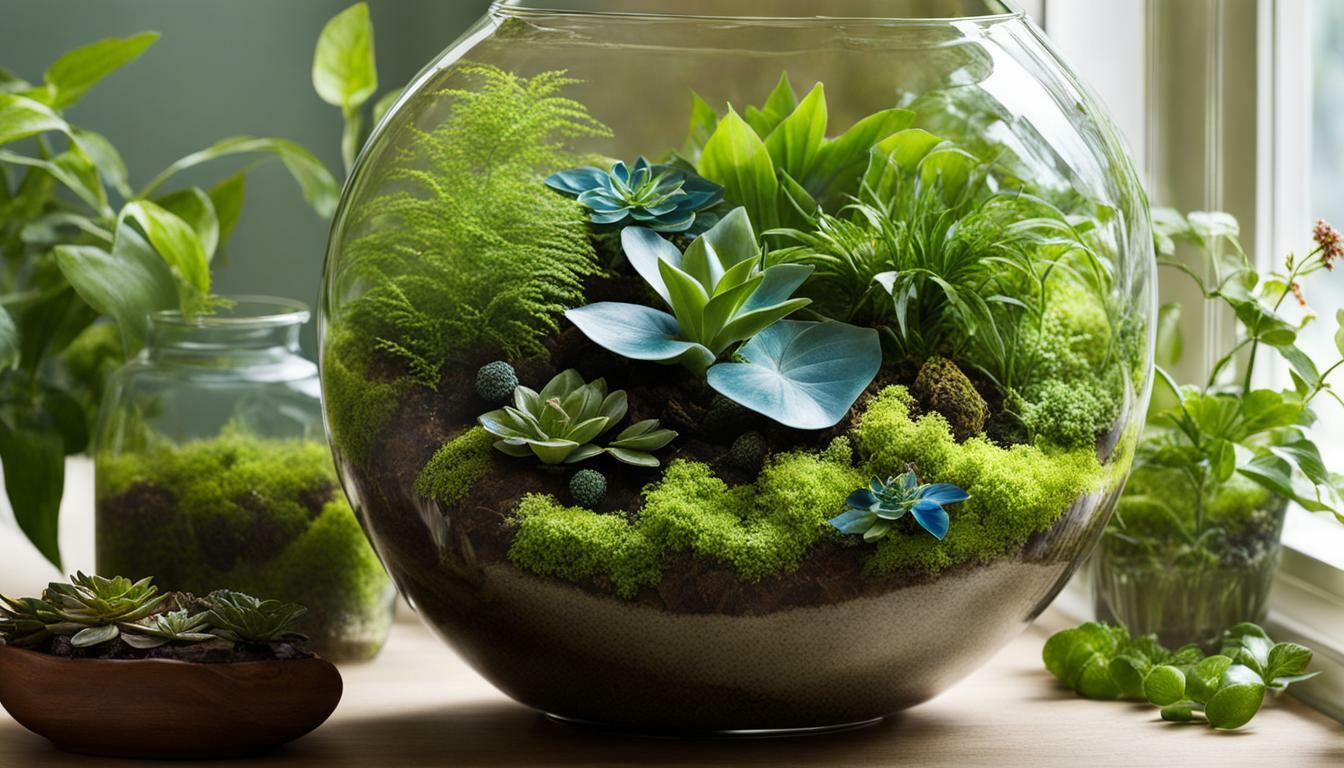Terrarium plants are a great way to bring greenery into your home, and shade-loving plants are the perfect option for those with limited access to direct sunlight. These plants can thrive in terrariums with low to medium levels of light, making them an ideal choice for indoor gardening enthusiasts. Whether you have a small apartment or simply want to add a touch of nature to your living space, shade-loving terrarium plants are the answer.
Key Takeaways:
- Shade-loving terrarium plants are suitable for indoor environments with low to medium light levels.
- These plants require minimal light and water, making them low-maintenance and easy to care for.
- Popular shade-loving plants for terrariums include the Prayer Plant, Nerve Plant, Lucky Bamboo, Laceleaf Anthurium, Peace Lily, Silver Lace Fern, Crocodile Fern, Button Fern, Autumn Fern, Earth Star Plant, Peat Moss, and various types of terrarium moss.
- Shade-loving plants can provide beautiful foliage and texture, creating a lush and vibrant atmosphere in your home.
- Terrariums with shade-loving plants are a great option for those with limited access to direct sunlight.
Benefits of Shade-Loving Plants in Terrariums
Terrariums with low-light conditions offer a unique opportunity to grow beautiful indoor gardens with shade-loving plants that require minimal care. These plants thrive in environments with limited sunlight, making them perfect for terrariums placed in areas with little natural light, such as offices or rooms with small windows.
One of the main advantages of using shade-loving plants in terrariums is their low-maintenance nature. These plants typically require less water and attention compared to sun-loving plants, as they have adapted to survive in darker environments. This makes them ideal for busy individuals or those new to gardening, as they can thrive even with minimal care.
Low-light terrarium plants also offer a wide variety of foliage and texture options, allowing you to create a lush and visually appealing indoor garden. From the vibrant leaves of the Nerve Plant to the elegant appearance of Lucky Bamboo, these shade-loving plants can add color and style to any terrarium.
Furthermore, these plants can contribute to improving indoor air quality by absorbing toxins and releasing oxygen. The Peace Lily, for example, is known for its ability to filter harmful pollutants from the air, making it a popular choice for terrariums in homes or offices.
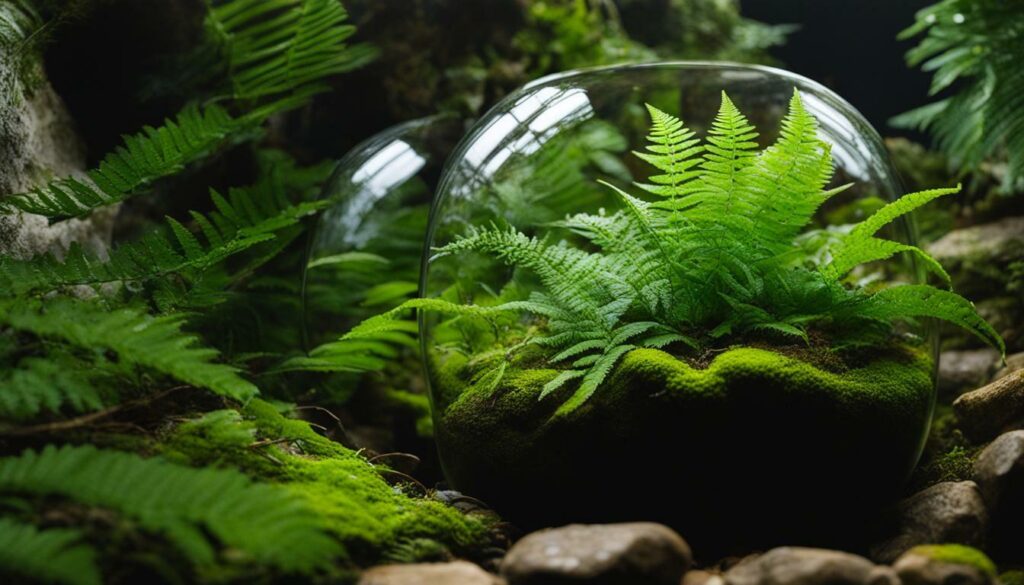
| Plant Name | Care Requirements | Main Characteristics |
|---|---|---|
| Prayer Plant | Low to medium light, moderate humidity | Unique foliage that folds up at night |
| Nerve Plant | Low to medium light, high humidity | Vibrant leaves with intricate patterns |
| Lucky Bamboo | Low to medium light, water occasionally | Elegant long stems and lush foliage |
| Laceleaf Anthurium | Low to medium light, high humidity | Large, heart-shaped leaves with a glossy appearance |
| Peace Lily | Low to medium light, keep soil moist | White flowers and dark green foliage |
In conclusion, low-light terrarium plants offer a range of benefits for indoor gardening enthusiasts. With their ability to thrive in shade and minimal care requirements, these plants are perfect for creating vibrant and low-maintenance terrariums. Whether you’re looking for unique foliage, elegant appearance, or air-purifying qualities, shade-loving plants have something to offer. So, embrace the beauty of low-light terrarium gardening and enjoy the benefits of a green oasis in your home or office.
Popular Shade-Loving Plants for Terrariums
There are several shade-loving plants that are well-suited for terrariums, offering a variety of colors, textures, and foliage to create a visually appealing indoor landscape. These plants thrive in low-light conditions and require minimal care, making them ideal for those with busy lifestyles or limited access to natural sunlight.
One popular shade-loving plant for terrariums is the Prayer Plant (Maranta leuconeura). Known for its unique foliage, this plant features vibrant green leaves with striking patterns. It thrives in low-light conditions and can add a touch of elegance and beauty to any terrarium. With proper care, the Prayer Plant can grow well in moist soil and create a lush and tropical atmosphere within your terrarium.
Another excellent choice for a shade-loving terrarium plant is the Nerve Plant (Fittonia spp.). This plant is famous for its colorful and intricate leaves, with patterns that range from bright pink to deep green. The Nerve Plant is highly adaptable to low-light conditions and can thrive in terrariums with indirect sunlight. Its delicate appearance and vibrant foliage make it a visually stunning addition to any indoor garden.
The Lucky Bamboo (Dracaena sanderiana) is a shade-loving plant often used in terrariums due to its elegant and graceful appearance. This plant requires minimal light and can tolerate low-light environments, making it an excellent choice for terrariums with limited access to natural sunlight. The Lucky Bamboo can bring a sense of tranquility and serenity to your terrarium, creating a soothing environment for you to enjoy.
Table 1: Shade-Loving Plants for Terrariums
| Plant | Light Requirements | Care Level |
|---|---|---|
| Prayer Plant | Low-light conditions | Low maintenance |
| Nerve Plant | Indirect sunlight | Easy care |
| Lucky Bamboo | Low-light environments | Minimal care |
These are just a few examples of shade-loving plants that can thrive in terrariums. Other popular options include the Laceleaf Anthurium (Anthurium crystallinum), Peace Lily (Spathiphyllum spp.), and various fern species. Each plant offers its own unique characteristics and can contribute to creating a lush and vibrant atmosphere within your terrarium. Experiment with different combinations to find the perfect blend of colors and textures that suit your personal style and preferences.
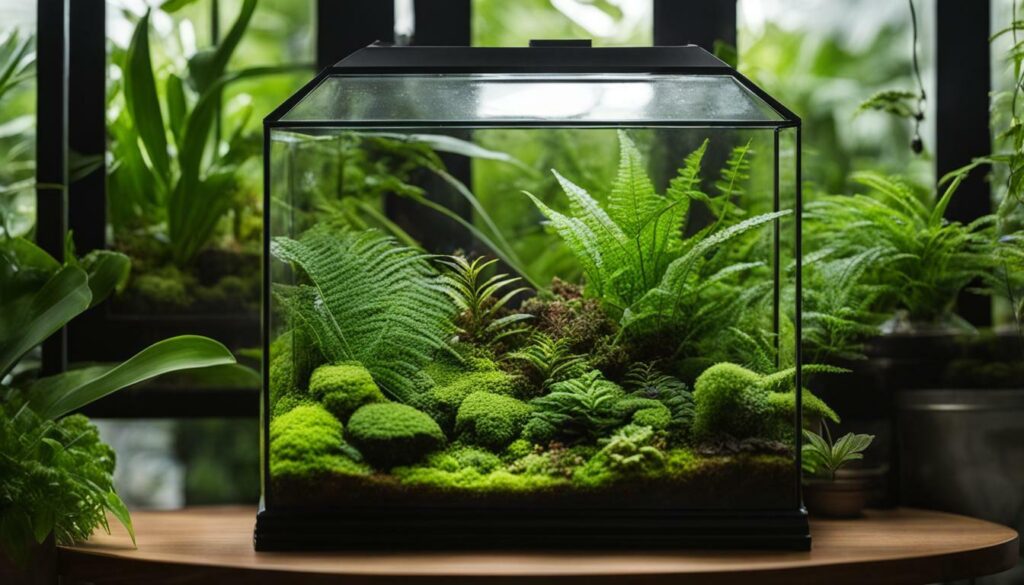
Prayer Plant (Maranta leuconeura)
The Prayer Plant, also known as Maranta leuconeura, is a stunning shade-loving plant that is sure to add a touch of elegance to any terrarium. With its unique foliage and vibrant colors, it is a popular choice among terrarium enthusiasts.
The Prayer Plant gets its name from its unique habit of folding its leaves together at night, resembling hands in prayer. This fascinating behavior makes it a captivating plant to observe and adds a dynamic element to any terrarium.
One of the key advantages of the Prayer Plant is its ability to thrive in low-light conditions. It can tolerate indirect sunlight or artificial light, making it an excellent choice for terrariums placed in shaded areas of your home. Its low light requirements make it a low-maintenance plant that is perfect for busy individuals or those new to terrarium gardening.
When caring for the Prayer Plant in a terrarium, it is important to provide it with well-draining soil and water it regularly to keep the soil moist. It prefers a humid environment, which can be achieved by misting the plant or placing a tray of water near the terrarium. With proper care, the Prayer Plant will reward you with its stunning foliage and thrive in your terrarium for years to come.
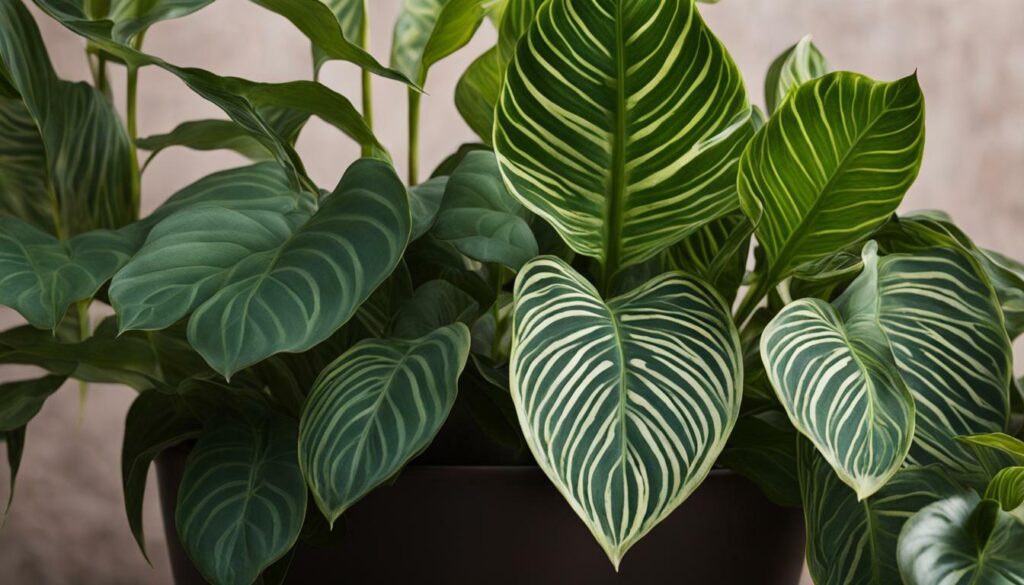
- Place the terrarium in a shaded area away from direct sunlight.
- Use well-draining soil to prevent waterlogging.
- Water the plant regularly to keep the soil moist but not soggy.
- Mist the plant occasionally to provide the desired humidity.
- Feed the plant with a balanced, water-soluble fertilizer once a month during the growing season.
With its stunning foliage and low-light adaptability, the Prayer Plant is a must-have for any terrarium enthusiast. Its unique characteristics and easy care requirements make it a perfect choice for beginners and experienced gardeners alike. Add a touch of elegance and natural beauty to your terrarium with the Prayer Plant.
Nerve Plant (Fittonia spp.)
The Nerve Plant, also known as Fittonia, is a popular choice for terrariums due to its eye-catching foliage and ability to tolerate shade. With its striking veined leaves in various shades of green, red, and pink, it adds a burst of color and texture to any terrarium. Whether you have a low-light or medium-light terrarium, the Nerve Plant can thrive and create a lush green oasis in your home.
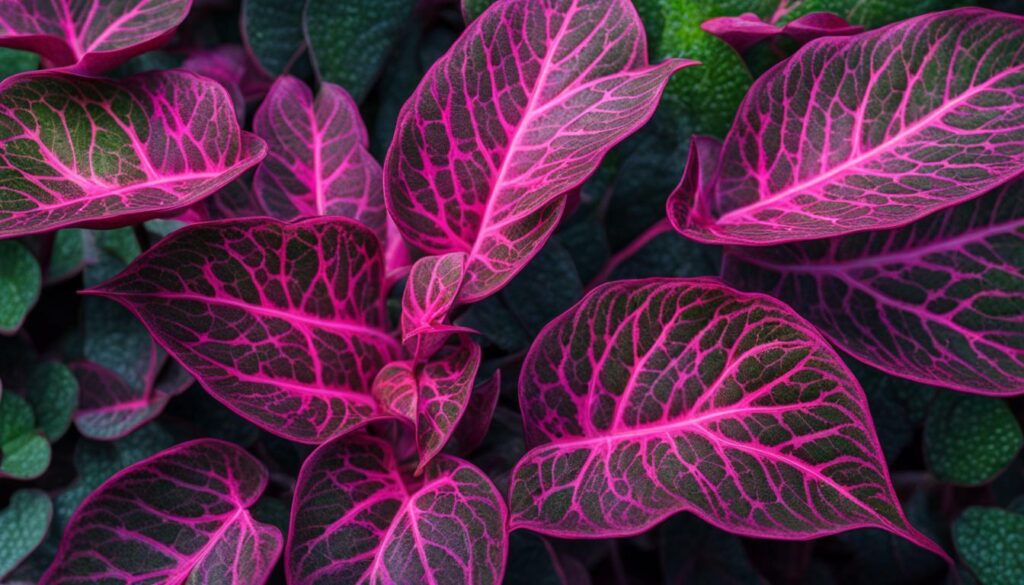
One of the advantages of the Nerve Plant is its low-maintenance nature. It requires minimal care, making it ideal for those with busy schedules. Simply place it in a terrarium with well-draining soil and mist the leaves occasionally to provide moisture. The Nerve Plant also appreciates a humid environment, so consider using a terrarium with a lid or misting the surrounding area regularly.
In addition to its aesthetic appeal, the Nerve Plant also offers air-purifying benefits. It helps to remove toxins from the air, creating a cleaner and healthier indoor environment. This makes it an excellent choice for those looking to enhance their home’s air quality while enjoying the beauty of nature.
To showcase the Nerve Plant’s unique foliage, consider placing it on a shelf or tabletop where it can be easily admired. Its vibrant leaves will add a pop of color to any space, making it a stunning centerpiece or accent plant in your home. So, if you’re searching for a shade-loving plant that is both visually appealing and easy to care for, the Nerve Plant is a perfect choice for your terrarium.
Lucky Bamboo (Dracaena sanderiana)
Lucky Bamboo, scientifically known as Dracaena sanderiana, is a popular choice among terrarium enthusiasts for its graceful growth pattern and versatile shade tolerance. This beautiful plant features slender stalks with lush green foliage, adding a touch of elegance to any terrarium. Its ability to thrive in low light conditions makes it an ideal choice for those seeking low-maintenance terrarium plants.
One of the unique characteristics of Lucky Bamboo is its ability to grow both in soil and water. It can be planted directly in the substrate of your terrarium or be placed in a water-filled vase, allowing its roots to absorb nutrients and moisture. This versatility makes it a great option for terrariums of different styles and setups.
To provide optimal care for your Lucky Bamboo, ensure that it is placed in indirect or filtered light. Avoid placing it in direct sunlight as it can lead to scorched or yellowed leaves. Keep the soil or water consistently moist, but not waterlogged, as excessive moisture can cause root rot. Regularly misting the foliage with water will help to maintain the plant’s humidity requirements.
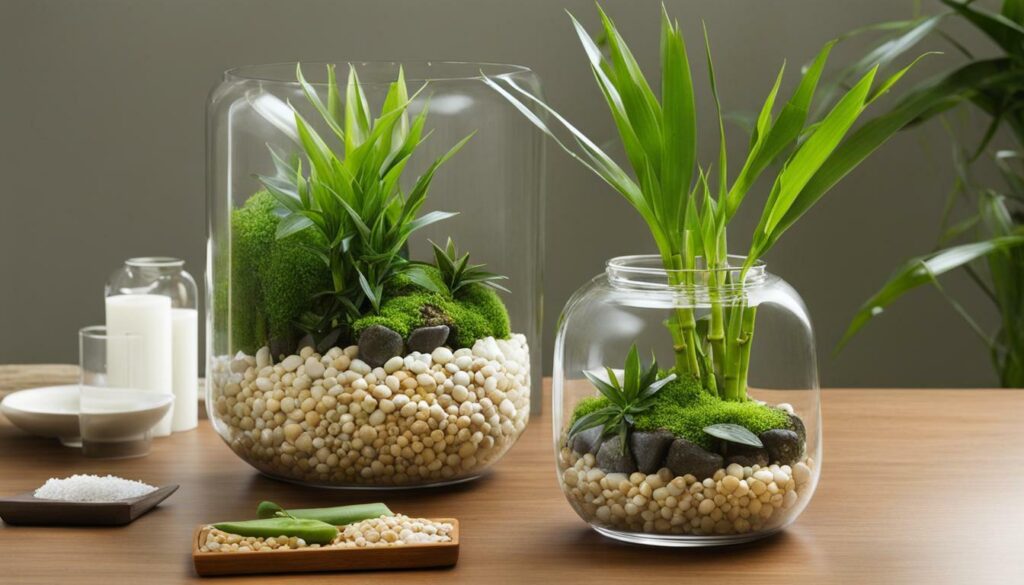
Lucky Bamboo can be paired with other shade-loving plants, such as ferns or moss, to create a captivating terrarium display. Its vertical growth and vibrant green color make it a striking focal point in your terrarium arrangement. Whether you place it in a closed or open terrarium, Lucky Bamboo is sure to bring a sense of tranquility and natural beauty to your indoor space.
Laceleaf Anthurium (Anthurium crystallinum)
The Laceleaf Anthurium, scientifically known as Anthurium crystallinum, is a shade-loving plant that adds a touch of tropical beauty to any terrarium. With its large, heart-shaped leaves and velvety texture, this plant is a stunning centerpiece that will thrive in low-light conditions. Its unique foliage features contrasting veins that create an eye-catching pattern, making it a popular choice among plant enthusiasts.
When it comes to care, the Laceleaf Anthurium prefers moist, well-draining soil and indirect light. It is important to provide adequate humidity for this plant by misting the leaves regularly or placing a humidity tray nearby. Avoid overwatering, as this can lead to root rot. Instead, allow the top inch of soil to dry out between waterings to prevent any waterlogged conditions.
This shade-loving plant can be grown in a variety of terrarium setups, including closed or open containers. Its compact size makes it an ideal choice for smaller terrariums, but it can also be used as a focal point in larger setups. With its low-light adaptability and vibrant foliage, the Laceleaf Anthurium will bring a touch of elegance to your indoor garden.
| Growth Conditions | Watering | Lighting |
|---|---|---|
| Moist, well-draining soil | Allow the top inch of soil to dry out between waterings | Indirect light or low-light conditions |
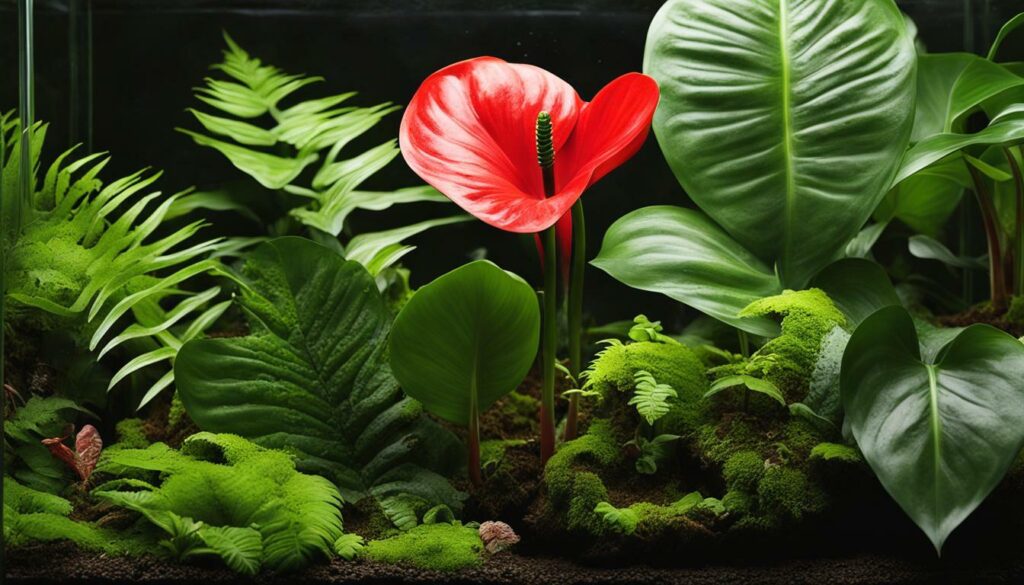
In summary, the Laceleaf Anthurium is a shade-loving plant that thrives in low-light terrarium environments. Its unique foliage and tropical charm make it a popular choice among terrarium enthusiasts. By providing the right conditions of moisture and indirect light, you can enjoy the beauty of this plant in your indoor garden. So why not consider adding the Laceleaf Anthurium to your terrarium collection and create a lush and vibrant atmosphere in your home.
Peace Lily (Spathiphyllum spp.)
The Peace Lily, scientifically known as Spathiphyllum spp., is a beautiful and low-maintenance shade-loving plant that can add a touch of serenity to your terrarium. With its elegant white flowers and glossy green leaves, the Peace Lily is a popular choice for indoor gardens.
This plant thrives in low-light conditions, making it perfect for terrariums that receive minimal direct sunlight. It can tolerate low to medium levels of light, making it an ideal choice for those looking to create a lush and vibrant atmosphere in their home.
The Peace Lily is also known for its air-purifying properties, making it a great addition to any indoor space. It can help improve the air quality by filtering out toxins and pollutants, creating a healthier environment for you and your plants.
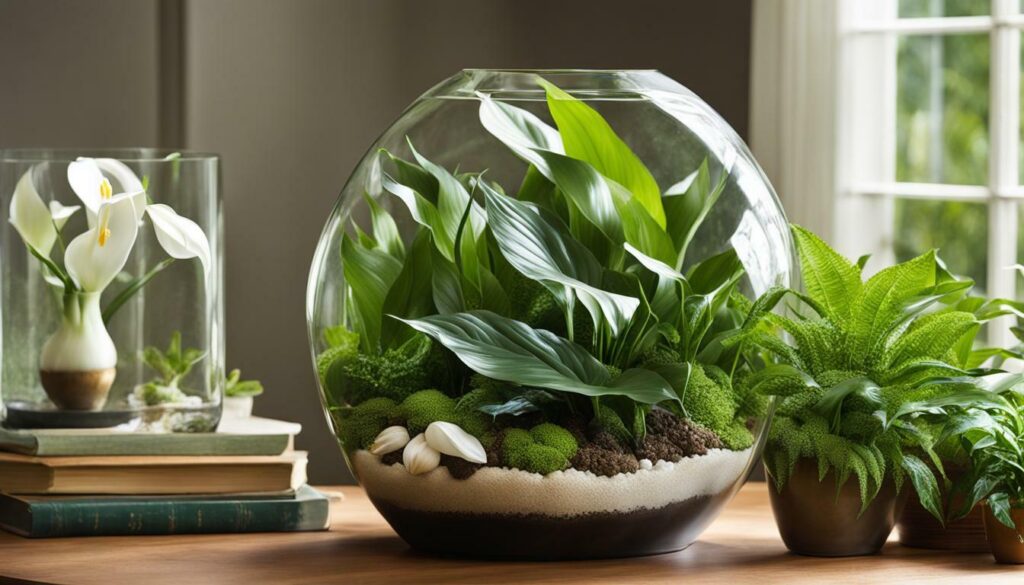
When caring for the Peace Lily in your terrarium, it is important to keep the soil moist but not overly saturated. Watering once a week or when the top inch of soil feels dry is usually sufficient. This plant prefers high humidity, so misting the leaves occasionally can help create the ideal environment.
With its graceful appearance and easy care requirements, the Peace Lily is a versatile shade-loving plant that can thrive in low-light terrarium conditions. Whether you’re a beginner or an experienced plant enthusiast, adding a Peace Lily to your terrarium is sure to bring a sense of tranquility and beauty to your indoor oasis.
Ferns for Terrariums
Ferns are a popular choice for terrariums due to their ability to thrive in shade and add a delicate touch of greenery to any indoor space. These low-light terrarium plants are known for their feathery fronds and can create a lush and vibrant atmosphere in your home. Here are some popular fern species that are well-suited for terrariums:
- Silver Lace Fern (Pteris ensiformis): This fern has delicate, lacy fronds that add an elegant touch to any terrarium. It thrives in humid environments and can tolerate low light conditions.
- Crocodile Fern (Microsorum musifolium): Named for its unique textured fronds, the Crocodile Fern is a striking addition to any terrarium. It prefers medium to low light and requires regular misting to maintain humidity.
- Button Fern (Pellaea rotundifolia): This small fern features round, button-like leaflets that give it a distinctive appearance. It can tolerate low light conditions and prefers high humidity.
- Autumn Fern (Dryopteris erythrosora): The Autumn Fern gets its name from its vibrant copper-colored fronds. It is a hardy fern that can tolerate a range of light conditions, including low light.
- Earth Star Plant (Cryptanthus spp.): While technically not a fern, the Earth Star Plant is often included in terrariums due to its low light requirements and unique rosette-shaped foliage.
When selecting ferns for your terrarium, consider the size of your container and the overall aesthetic you want to achieve. Ferns with smaller fronds, like the Silver Lace Fern and Button Fern, work well in smaller terrariums, while larger varieties like the Crocodile Fern and Autumn Fern can be the centerpiece of larger terrariums.
Remember to place your ferns in well-draining soil and water them sparingly to avoid waterlogged conditions. Mist the foliage regularly to maintain humidity, especially if your terrarium has a closed or partially closed lid. With the right care and attention, ferns can thrive in low-light terrarium environments, bringing a touch of natural beauty and tranquility to your indoor space.
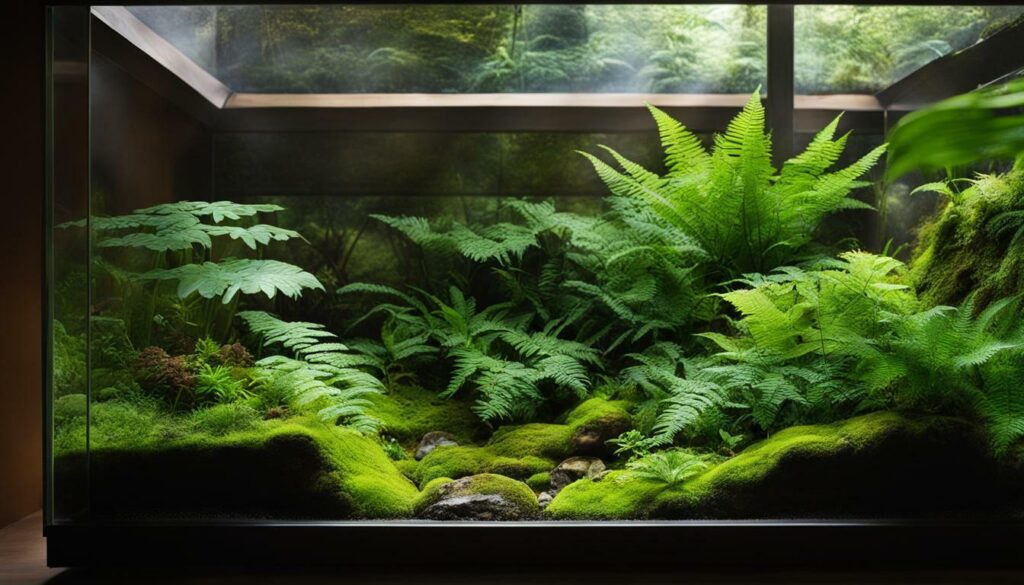
Terrarium moss is a crucial element in shade-loving terrariums, providing moisture control and adding a natural, forest-like feel to the environment. This type of moss, also known as sheet moss or carpet moss, is commonly used to create a lush and verdant ground cover in terrariums. It not only enhances the aesthetic appeal of the miniature ecosystem but also serves important functions in maintaining a healthy and balanced environment for the plants.
One of the key benefits of terrarium moss is its ability to retain moisture. It acts as a sponge, absorbing and holding water, which is essential for the plants in low-light terrariums. This helps to create a humid environment, mimicking the natural conditions that many shade-loving plants thrive in. The moss also helps to regulate the moisture levels, preventing the soil from becoming waterlogged and ensuring that your plants receive just the right amount of hydration.
In addition to its moisture control properties, terrarium moss also adds a touch of natural beauty to your terrarium. Its vibrant green color and delicate texture create a visually appealing contrast against the foliage of other shade-loving plants. The soft and springy nature of the moss provides a comfortable and natural substrate for the plants to grow in.
Types of Terrarium Moss
There are several different types of terrarium moss available, each with its own unique characteristics. Some popular varieties include:
- Sphagnum Moss: This type of moss is known for its excellent water retention and is often used as a top dressing in terrariums.
- Peat Moss: Peat moss is an excellent choice for terrariums with high humidity requirements. It helps to maintain moisture levels while also providing good aeration for the roots of the plants.
- Java Moss: Java moss is a versatile and fast-growing moss that can be used to create a lush carpet effect in your terrarium. It has a vibrant green color and adds a touch of vibrancy to the overall look of the terrarium.
When selecting terrarium moss for your shade-loving terrarium, it’s important to consider the specific needs of your plants and the overall aesthetic you want to achieve. Remember to regularly mist the moss to keep it hydrated and healthy, and trim any excess growth to maintain a neat and tidy appearance.
| Moss Type | Moisture Retention | Growth Rate | Appearance |
|---|---|---|---|
| Sphagnum Moss | High | Slow | Soft, fluffy, and compact |
| Peat Moss | High | Medium | Dark and fibrous |
| Java Moss | Medium | Fast | Fine and feathery |
With the inclusion of terrarium moss in your shade-loving terrarium, you can create a beautiful and thriving miniature world that brings the beauty of nature indoors. Its moisture control properties, along with its natural appearance, make it an indispensable component for maintaining the health and vitality of your plants in low-light conditions.
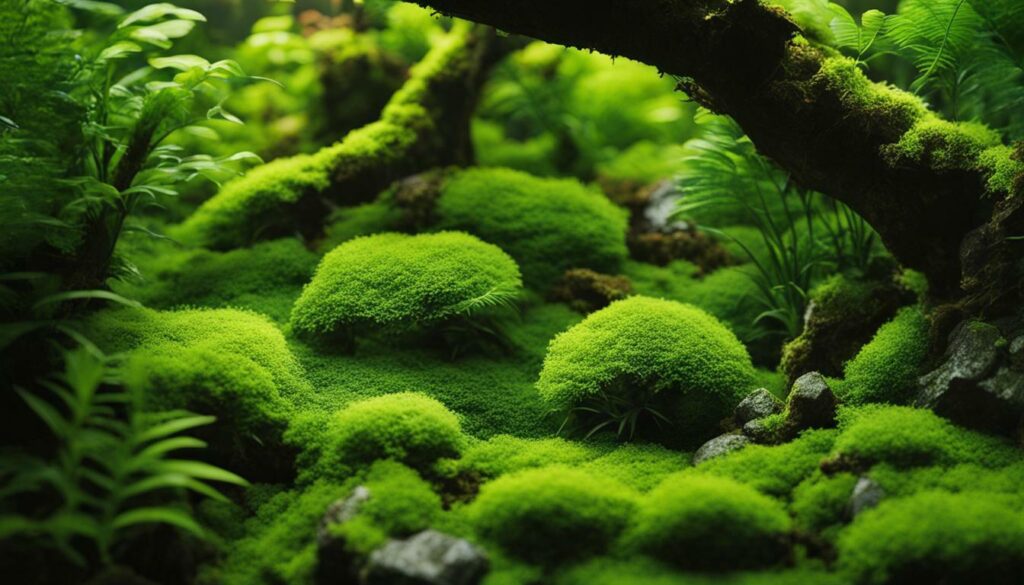
Incorporating shade-loving plants into your terrarium can transform it into a green oasis, even in low-light conditions. With a wide range of species to choose from, you can create a unique and thriving miniature ecosystem right in your home.
Low-light terrarium plants offer a great solution for those seeking to add life and color to their homes without the need for direct sunlight. These plants, such as the Prayer Plant, Nerve Plant, Lucky Bamboo, Laceleaf Anthurium, Peace Lily, and various ferns, thrive in terrariums with low to medium levels of light.
Not only do these shade-loving plants require minimal light and water, but they also provide beautiful foliage and texture. Their low-maintenance nature makes them perfect for busy individuals or those new to plant care. Whether you prefer the elegant appearance of the Lucky Bamboo or the vibrant foliage of the Nerve Plant, there is a shade-loving plant to suit every taste and style.
By creating a terrarium with low-light plants, you can bring the beauty of nature indoors and enjoy the benefits of having living greenery in your home. These plants not only enhance the aesthetics of your space but also contribute to a healthier atmosphere by purifying the air and reducing toxins.
So why wait? Start exploring the world of shade-loving terrarium plants today and create your own miniature indoor garden.Are Jade Plants Suitable for Shade-Loving Terrariums?
Jade plants are thriving jade terrarium plants and are not suitable for shade-loving terrariums. They require bright, indirect light to grow properly. Select shade-loving plants like ferns and mosses for terrariums in low-light conditions. Proper lighting is crucial for the health and growth of terrarium plants.
FAQ
What are low-light terrarium plants?
Low-light terrarium plants are species that can thrive in environments with minimal light. These plants require less direct sunlight and are perfect for adding life and color to your home without the need for a sunny spot.
What are the benefits of using shade-loving plants in terrariums?
Shade-loving plants are ideal for terrariums because they can thrive in low-light conditions. They require less maintenance compared to sun-loving plants and can create a lush and vibrant atmosphere in your home.
Which plants are suitable for terrariums with low light?
Some examples of low-light terrarium plants include the Prayer Plant, Nerve Plant, Lucky Bamboo, Laceleaf Anthurium, Peace Lily, Silver Lace Fern, Crocodile Fern, Button Fern, Autumn Fern, Earth Star Plant, Peat Moss, and various types of terrarium moss.
What are the unique characteristics of the Prayer Plant?
The Prayer Plant, also known as Maranta leuconeura, has unique foliage that folds up at night, resembling hands in prayer. It thrives in low-light conditions and is a popular choice for terrariums.
Why is the Nerve Plant suitable for terrariums?
The Nerve Plant, or Fittonia spp., is a versatile shade-loving plant that thrives in terrariums. It has vibrant foliage and requires minimal light, making it an excellent choice for low-light environments.
What makes Lucky Bamboo a popular choice for terrariums?
Lucky Bamboo, scientifically known as Dracaena sanderiana, is often used in terrariums for its elegant appearance and ability to thrive in low-light conditions. It adds a touch of serenity to any terrarium.
Why is the Laceleaf Anthurium recommended for terrariums?
The Laceleaf Anthurium, or Anthurium crystallinum, is a shade-loving plant with stunning foliage. It requires minimal light and can create a beautiful focal point in any terrarium.
What are the characteristics of the Peace Lily?
The Peace Lily, or Spathiphyllum spp., is a popular indoor plant with shade tolerance. It features elegant white flowers and can thrive in low-light terrarium environments.
Which ferns are suitable for terrariums with low light?
Various fern species, such as the Silver Lace Fern, Crocodile Fern, Button Fern, Autumn Fern, and Earth Star Plant, thrive in shade and are ideal for terrariums. These ferns add foliage and texture to your terrarium.
Why is terrarium moss important for shade-loving terrariums?
Terrarium moss plays a crucial role in creating a thriving ecosystem within the terrarium. It helps with moisture retention and adds aesthetic appeal. Different types of terrarium moss can be used to enhance the beauty of shade-loving terrariums.
What are the benefits of using shade-loving plants in terrariums?
Using shade-loving plants in terrariums allows you to add life and color to your home even in areas with minimal natural sunlight. These plants require less maintenance and can create a lush and vibrant atmosphere in your indoor space.

